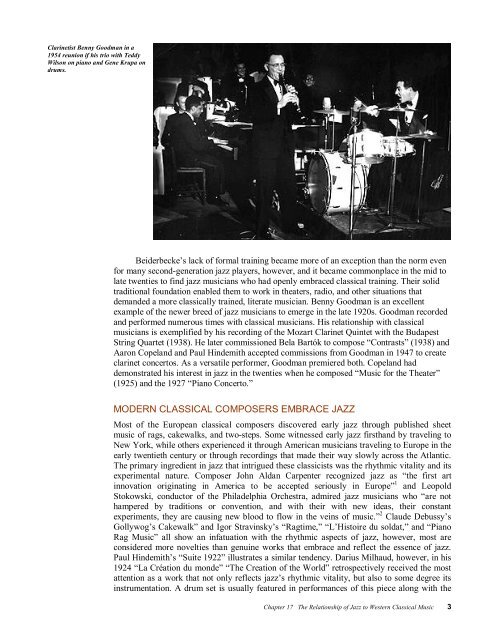THE RELATIONSHIP OF JAZZ TO WESTERN CLASSICAL MUSIC
THE RELATIONSHIP OF JAZZ TO WESTERN CLASSICAL MUSIC
THE RELATIONSHIP OF JAZZ TO WESTERN CLASSICAL MUSIC
You also want an ePaper? Increase the reach of your titles
YUMPU automatically turns print PDFs into web optimized ePapers that Google loves.
Clarinetist Benny Goodman in a<br />
1954 reunion if his trio with Teddy<br />
Wilson on piano and Gene Krupa on<br />
drums.<br />
Beiderbecke’s lack of formal training became more of an exception than the norm even<br />
for many secondgeneration jazz players, however, and it became commonplace in the mid to<br />
late twenties to find jazz musicians who had openly embraced classical training. Their solid<br />
traditional foundation enabled them to work in theaters, radio, and other situations that<br />
demanded a more classically trained, literate musician. Benny Goodman is an excellent<br />
example of the newer breed of jazz musicians to emerge in the late 1920s. Goodman recorded<br />
and performed numerous times with classical musicians. His relationship with classical<br />
musicians is exemplified by his recording of the Mozart Clarinet Quintet with the Budapest<br />
String Quartet (1938). He later commissioned Bela Bartók to compose “Contrasts” (1938) and<br />
Aaron Copeland and Paul Hindemith accepted commissions from Goodman in 1947 to create<br />
clarinet concertos. As a versatile performer, Goodman premiered both. Copeland had<br />
demonstrated his interest in jazz in the twenties when he composed “Music for the Theater”<br />
(1925) and the 1927 “Piano Concerto.”<br />
MODERN <strong>CLASSICAL</strong> COMPOSERS EMBRACE <strong>JAZZ</strong><br />
Most of the European classical composers discovered early jazz through published sheet<br />
music of rags, cakewalks, and twosteps. Some witnessed early jazz firsthand by traveling to<br />
New York, while others experienced it through American musicians traveling to Europe in the<br />
early twentieth century or through recordings that made their way slowly across the Atlantic.<br />
The primary ingredient in jazz that intrigued these classicists was the rhythmic vitality and its<br />
experimental nature. Composer John Aldan Carpenter recognized jazz as “the first art<br />
innovation originating in America to be accepted seriously in Europe” 1 and Leopold<br />
Stokowski, conductor of the Philadelphia Orchestra, admired jazz musicians who “are not<br />
hampered by traditions or convention, and with their with new ideas, their constant<br />
experiments, they are causing new blood to flow in the veins of music.” 2 Claude Debussy’s<br />
Gollywog’s Cakewalk” and Igor Stravinsky’s “Ragtime,” “L’Histoire du soldat,” and “Piano<br />
Rag Music” all show an infatuation with the rhythmic aspects of jazz, however, most are<br />
considered more novelties than genuine works that embrace and reflect the essence of jazz.<br />
Paul Hindemith’s “Suite 1922” illustrates a similar tendency. Darius Milhaud, however, in his<br />
1924 “La Création du monde” “The Creation of the World” retrospectively received the most<br />
attention as a work that not only reflects jazz’s rhythmic vitality, but also to some degree its<br />
instrumentation. A drum set is usually featured in performances of this piece along with the<br />
Chapter 17 The Relationship of Jazz to Western Classical Music 3

















